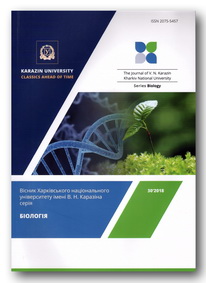Inheritance of traits in F1 hybrids of diploid einkorn wheat of the spring crop
Abstract
Diploid einkorn wheat (2n = 14) is an ancient crop that people cultivate for 10 thousand years. The grain of this wheat is a valuable product for a healthy diet, which determines the increasing interest in einkorn wheat by scientists and agricultural producers. Meanwhile, the wide use of this crop is hindered by several shortcomings that complicate the usage of modern technologies: low yield, ear fragility, a tendency to lodging, and difficult grain threshing. Nevertheless, there are some preconditions for improving the agronomic properties of this crop. We carried out crosses in seven combinations with the use of three wheat species (T. boeoticum, T. monococcum, T. sinskajae) to improve the diploid einkorn wheat in terms of productivity and threshing. In total, the hybrid seed set in the crosses varies from 6.3 % to 79.7 %. In the combination of cultivated wheat T. sinskajae with wild T. boeoticum, differences in the results of reciprocal crosses are observed specifically in the hybrid seed set (in the forward cross it equals 6.3 %; in the reverse one, 48.9 %). Hybrids from reciprocal crosses of T. monococcum var. sofianum UA0300649 and T. sinskajae f. aristata were equivalent in seed set (72 and 82 %) and inheritance patterns and had similar quantitative traits. In other combinations, the seed set varied from 12.5 to 45.6 %. Hybrid depression was the most frequent (22 cases out of 49) inheritance type of the F1 quantitative traits in einkorns; dominance of the parent form with a large trait manifestation was registered in 11 cases, and heterosis in four cases. In hybrids, the inheritance of spike length is correlated with the inheritance type of the ear number (r = 0.92) and the grain number (r = 0.78) per spike. The dominance degrees after these two traits are also highly correlated (r = 0.89). The combination UA0300400 T. boeoticum var. thaoudar ARM / UA0300224 T. sinskajae var. sinskajae RUS, which manifested heterosis for kernel number per spike (Hp = 1.2), the weight of spike (Hp = 11.8) and weight of kernels per spike (Hp = 5.4) is of particular interest. The combination UA0300222 T. monococcum var. hohensteinii / UA0300224 T. sinskajae var. sinskajae is promising for creating easily threshed material.
Downloads
References
Di Stasio L., Picascia S., Auricchio R. et al. (2020). Comparative analysis of in vitro digestibility and immunogenicity of gliadin proteins from durum and einkorn wheat. Front. Nutr., 7(56), 1–7. https://doi.org/10.3389/fnut.2020.00056
Filatenko A.A., Kurkiev U.K. (1975). Sinskaya Wheat (New species – Triticum sinskajae A. Filat. et Kurk.). Proceedings on Applied Botany, Genetics and Breeding, 54(1), 239–241. (In Russian)
Griffing B. (1956). Concept of general and specific combining ability in relation to diallel crossing systems. Australian journal of biological sciences, 9(4), 463–493.
Heun M., Schafer-Pregl R., Klawan D. et al. (1997). Site of Einkorn wheat domestication identified by DNA fingerprinting. Science, Washington, 278(5341), 1312–1314. https://doi.org/10.1126/science.278.5341.1312
Hidalgo A., Brandolini A. (2014). Nutritional properties of einkorn wheat (Triticum monococcum L.). J. Sci. Food Agric., 94 (4), 601–612. https://doi.org/10.1002/jsfa.6382
Kostylev P.I., Nekrasova O.A. (2015). Study of inheritance types of bread winter wheat several traits and its combining ability. Grain Economy of Russia, 6, 16–28. (in Russian)
Kuspira J., Maclagan J.M., Bhambhani R. et al. (1989). Genetic and cytogenetic analyses of the A genome of Triticum monococcum L. V. Inheritance and linkage relationships of genes determining the expression of 12 qualitative characters. Genome, 32(5), 869–881. https://doi.org/10.1139/G89-524
Ljubičić N., Petrović S., Dimitrijević M. et al. (2014). Diallel analysis for spike length in winter wheat. Turkish Journal of Agricultural and Natural Sciences. Special Issue, 2, 1455–1459.
Merezhko A.F., Udachin R.A., Zuev E.V. et al. (1999). Replenishment, preservation in living form and study of the world collection of wheat, aegilops and triticale. Guidelines. St. Petersburg: VIR, 81 p. (in Russian)
Mukhordova M.E. (2018). Genetic analysis of stalk length in diallel cross breeding of winter wheat. Bulletin of NSAU (Novosibirsk State Agrarian University), (1), 88–94. (in Russian)
Valekzhanin V.S., Korobeynikov N.I. (2016). The variability and inheritance of thousand-kernel weight in soft spring wheat varieties and hybrids in diallel crossing. Bulletin of Altai State Agricultural University, 7(141), 5–9.
Authors retain copyright of their work and grant the journal the right of its first publication under the terms of the Creative Commons Attribution License 4.0 International (CC BY 4.0), that allows others to share the work with an acknowledgement of the work's authorship.




